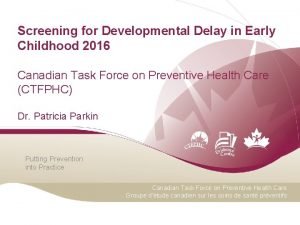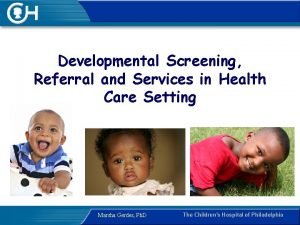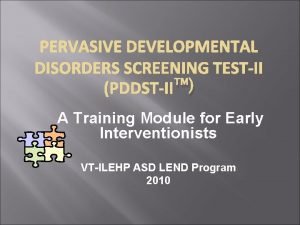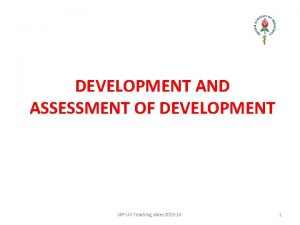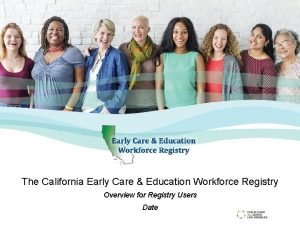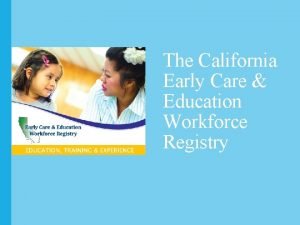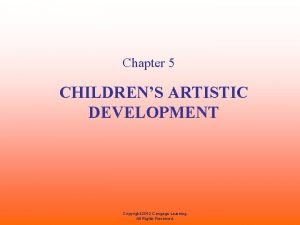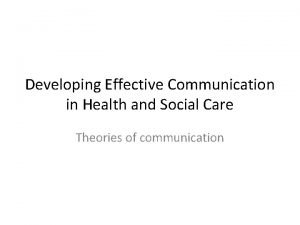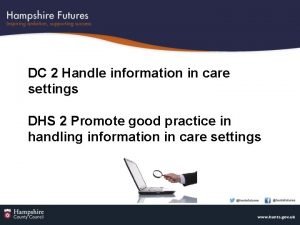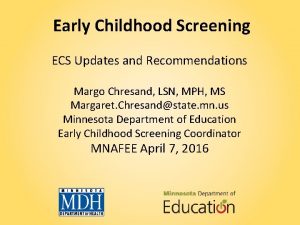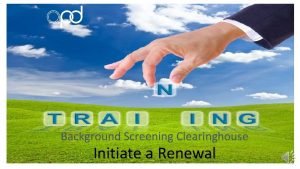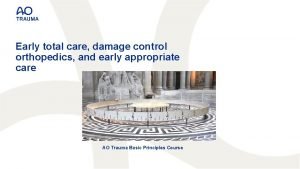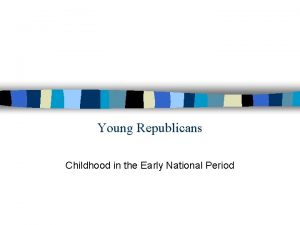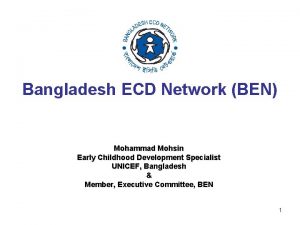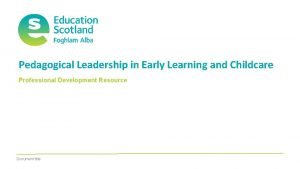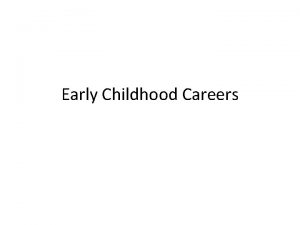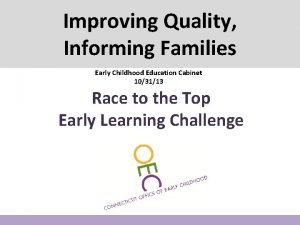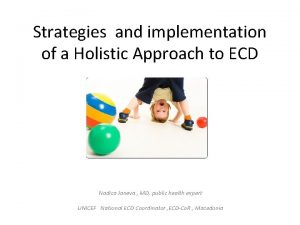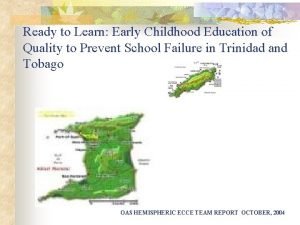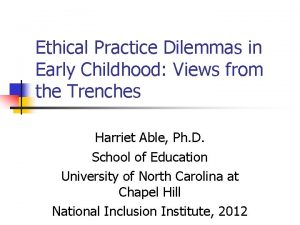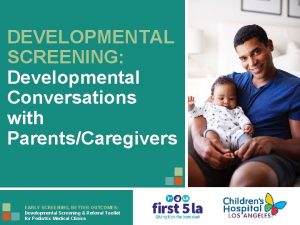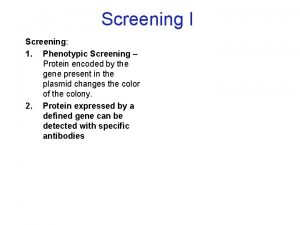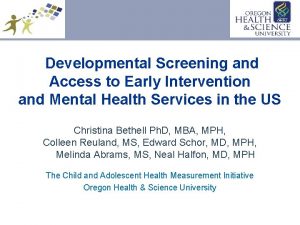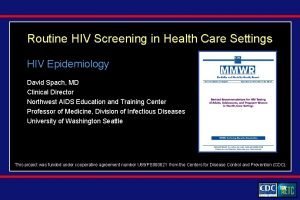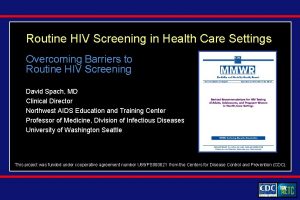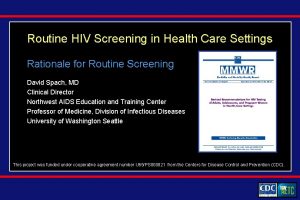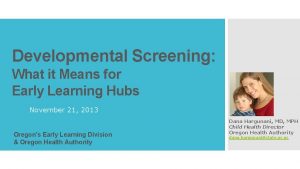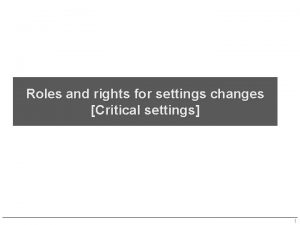Developmental Screening in Early Care and Education Settings








































- Slides: 40

Developmental Screening in Early Care and Education Settings Speakers : Elizabeth Isakson, MD, FAAP Evelyn J. Blanck, LCSW

Presentation Objectives • To emphasize the critical importance of the early years • To discuss early identification and intervention for social emotional and other developmental challenges • To describe the importance of AAP recommended practices around developmental screening and referrals • To identify the many roles that childcare plays in developmental screening and referrals • To develop a plan of action for improving current development screening practices

Importance of Early Identification and Intervention • 9. 5 -14. 2% of US children, ages 0 -5, experience social-emotional problems that negatively affect their functioning, development, and school readiness (Brauner & Stephens, 2006) • 12 -18% of US children have developmental or behavioral disorders – Speech and language impairments – Mental retardation and learning disorders – Emotional/Behavioral Disturbances • 70% of children with developmental disabilities and mental health problems are not identified until school entry (Glascoe, FP, MRDD Research Reviews 2005)

Importance of Early Identification and Intervention 85% of brain development occurs before age 3 Research shows the best time to intervene to optimize development and eliminate disparities is in the first five years of life.

Why Developmental Screening Matters • Identifies problems that otherwise go unnoticed at point of maximum impact • Identifies children in need of further assessment • Enables qualifying children, ages 0 -5, access to needed services – Early Intervention and Preschool Special Education through IDEA (special education, OT, PT, counseling, family training) u Children qualify based on delays in 5 Domains of Development: ü ü ü Cognitive Language Motor Social-Emotional Adaptive – Mental Health Services

The Important Role of Early Care and Educators • Early Care and Education providers are in an ideal position to assess children’s development and often are the first one to observe potential delays • Providers have relationships with the parents and can partner with them in monitoring and celebrating their child’s development

Why Social Emotional Health Is Important Social emotional health provides an essential foundation that supports all other aspects of a child’s development from; o the formation of friendships o the ability to cope with adversity o the achievement of success in school, work, and community life. • If young children are not provided appropriate help, emotional difficulties that emerge early in life can become more serious disorders over time

Brain Research: What Science Tells Us • Neuroscientists have discovered that the quality of early childhood relationships affect brain architecture. Brain scans of young children with strong nurturing primary relationships were very different from those of children with disorganized attachments to primary caregivers, or children with trauma or toxic stress • The quality and consistency of early relationships impacts young children’s ability to learn, their sensory processing, their ability to self-regulate, and their ability to form relationships

Trauma In Young Children: A Huge Problem Hiding In Plain Sight and How You Can Help Presentation to the Early CPEare and Education. Presentation to the Early Care and Education • Steering Co

Economic Incentives to Intervene Early • James Heckman, Nobel winning economist, analyzed the return on investment for human capital at various life stages • Early interventions have much higher economic returns. The highest are in 0 -3.


Early Identification and School Readiness • Behavior problems in preschool years predict continued behavior problems, poor peer standing, and academic difficulties in Kindergarten • Some preschoolers enter early education with severe behavioral problems, limiting their ability to fully participate in and benefit from the experience and frequently resulting in expulsion

Identifying Children with Potential Delays/Problems ü SURVEILLANCE ü SCREENING ü EVALUATION

Surveillance The process of recognizing children at risk of developmental delays • Observe children’s behaviors – Learn the signs. Act early. – Discuss parent observations and concerns, problems at home, child’s behavior, and areas the child is lagging behind • Captures about 30% of problem children

Screening Use of standardized tools to identify children at risk of a developmental delay or disorder • Ask questions about a child’s development, including language, motor, cognitive, and social/emotional • Involve parents and focus on positive development • Rely on standardized screening instruments over clinical impressions/observations • Include all children in the screening program • Identify children with possible delays

Evaluation A formal process aimed at identifying specific developmental disorders affecting a child • Usually done by a trained specialist (i. e. , psychologist, pathologist, developmental pediatrician) • Involves child observation, parent/caregiver interviews, and standardized tests • Refers diagnosed children for early intervention, preschool special ed, or mental health services • NOTE! Following-up with families and early care providers is important!

Engaging Parents • Parents are the experts on their children, and children develop in the context of relationships • The early years set the stage for sturdy or fragile existence. Development depends on the quality and reliability of their relationships (Shonkoff, National Scientific Council on the Developing Child)

Helping Families and Providers • CELEBRATE MILESTONES! Every family looks forward to their child’s first smile, first step, and first words. Regular screenings raise awareness of a child’s development, making it easier to anticipate and celebrate milestones • PROMOTE UNIVERSAL SCREENINGS! Much as hearing and visions screenings assure children can hear and see, developmental and behavioral screenings assure language, social, and motor developmental progress • IDENTIFY DELAYS AND CONCERNS EARLY! Children get the supports they need, as early as possible • ENHANCE DEVELOPMENTAL SUPPORTS! Combine family love with expert tools, guidance, and tips to make the most of children’s developmental support

Birth to Five, Watch Me Thrive • A screening passport allows parents to monitor developmental progress • It tracks screening results and shares information with providers (Available on Birth to Five; Watch Me Thrive Website)

New York Ranking of percent of young children (10 months-5 years) that received a standardized developmental screening, 2011. WE CAN DO BETTER!

Surveillance and Screening Guidelines: AAP 2006 Developmental surveillance at every well-child visit – if concerns then formal screen Developmental screening using a standardized screening tool at 9, 18, and 30* months or when concern is expressed If results are concerning, refer for developmental and medical evaluations and early intervention services Follow up on referrals made and continually track child’s developmental status

Early Educators : uniquely poised • • Keen observers and window to child development Innate “surveillance” Making surveillance intentional Communicating with families to celebrate and anticipate milestones Promoting Screening: families to expect from wcc Implementing screening Communicating with medical home Communicating and linking with community resources

BRIGHT FUTURES: A VISION

Screening Works Detection Rates Without With standardized, valid, reliable tool • 30% of developmental disabilities identified (Palfrey et al. JPEDS. 1994; 111: 651 -655) • 70 -80% with developmental disabilities correctly identified (Squires et al. , JDBP 1996; 17: 420 -427) 24

What is the ASQ? • The Ages & Stages Questionnaires® (ASQ) Third Edition is questionnaire designed to help parents check their child's development • Parents can use the results of the ASQ to help talk with pediatricians, teachers or other professionals if they have concerns about their child's development. • The core of ASQ is a series of 20 questionnaires that correspond to age intervals from birth to 6 years. • Each questionnaire contains simple questions for parents to answer about activities their child is (or is not) able to do. • The answers are scored and help to determine whether the child's development is on schedule or whether the child should be referred for a developmental checkup with a professional. • Activities discussed in each questionnaire reflect developmental milestones for each age group. • Parents can learn more about what to expect their child to be able to do at each stage of development. Ages & Stages Questionnaires® is a registered trademark and ASQ-3™ and related logos are trademarks of Paul H. Brookes Publishing Co. , Inc. Copyright © 2010 Paul H. Brookes Publishing Co. All rights reserved. 25

Comparison ASQ • Appropriate for ages 2 months 5½ years • Assesses skills in language, personal-social, fine/gross motor, problem solving • Parent-completed • Requires 6 th grade reading level • 30 items/10 -15 minutes to complete • Identifies children requiring further evaluation to determine need for referral or intervention PEDS • Appropriate for ages birth to 8 years • Identifies children as low, moderate or high risk for various disabilities and delays • Indicates when to refer, conduct additional screen, provide parent education or monitor • Approximately 10 items/10 minutes to complete • Parent completed • Available in many languages 26

Sample ASQ Tool Copyright © 2014 Paul H. Brookes Publishing Co. , Inc. All Rights Reserved. 27

COMMUNICATING WITH FAMILIES

Describing screening to parents • “This tool is a way that you can check your child’s development” • “Your child will be able to do some of the items, but not all of the items” • “You can help your child practice these skills” • “Your answers help show your child’s strengths and any areas where your child may need support or more practice”

• • • Communicating screening results Provide clear, accurate information. Listen carefully to parents’ questions and concerns. Consider developing a script that can be adapted, such as: “Your responses to the screening questions agreed with the concerns you shared with me about your child’s development. The results indicate that further evaluation is recommended. ” Ensure that parents understand the information shared. Adapted from: National Professional Development Center on Autism Spectrum Disorders

Communicating screening results • • • Encourage parents to recognize child’s strengths. Have concrete, written plans for next steps to share with parents. Following a screening, this might be making a referral for a diagnostic assessment. Provide parents with resources for obtaining additional information, services and supports (e. g. , web sites, written materials, a phone number for a resource center). Be culturally sensitive, use easily understood words, beware of culturally loaded words.

Addressing positive screens • Create directory of • Refer for additional evaluation. • Document in medical record. • Include follow-up activities (follow-up visits), interventions. community resources. • Establish systematic protocols for parent education, consultation, referral and intervention. • Engage community network of linked service providers.

Community Resource Guide Resource guide of community mental health and early childhood resources should include: ü ü ü Location of service delivery site Ages served Specialization Waiting time until appointment Forms of accepted payment Contact person Foy, J. M. , Kelleher, K. J. , Laraque, D. , & AAP Task Force on Mental Health. , (2010). Pediatrics, 125(Supplement 3), S 87 -S 108.

CURRENT FLOW

Imbed Screening in Current Flow • Add screening information, release of information, and referral • • protocol to existing forms Build on existing relationships with medical home or plan to improve Include screening forms in mailed, pre-visit questionnaires to parents. Include milestone logs/ routine parent communication Parent and staff education Map workflow for staff, orient staff to screening tools and procedures. Incorporate screening documentation into records Develop and document referral and follow-up protocols.




CONNECTING WITH THE MEDICAL HOME

CONNECTIONS: BRIDGING • • Linkages/Referrals Communication around a particular child Advisory around health issues Episodic/training/information Longitudinal advisory Shared Vision Collaboration and Partnership
 Denver developmental screening test
Denver developmental screening test Developmental screening vs surveillance
Developmental screening vs surveillance Trivandrum developmental screening chart
Trivandrum developmental screening chart Trivandrum developmental screening test
Trivandrum developmental screening test Pervasive developmental disorder screening test
Pervasive developmental disorder screening test Iap teaching
Iap teaching Acecqa self assessment tool
Acecqa self assessment tool Early care and education workforce registry
Early care and education workforce registry Ca workforce registry
Ca workforce registry Emotional development in early adulthood
Emotional development in early adulthood Kellogg's developmental stages of art
Kellogg's developmental stages of art One to one communication in health and social care
One to one communication in health and social care Handling information in health and social care
Handling information in health and social care Early screening inventory
Early screening inventory Early childhood screening rochester mn
Early childhood screening rochester mn Levels of nursing care primary secondary tertiary
Levels of nursing care primary secondary tertiary Early cpr and early defibrillation can: *
Early cpr and early defibrillation can: * Care provider background screening clearinghouse
Care provider background screening clearinghouse Rockefeller professional development
Rockefeller professional development Isaac newton early life and education
Isaac newton early life and education Early total care
Early total care Newborn care objectives
Newborn care objectives Saraland early education
Saraland early education Trends in early childhood education
Trends in early childhood education Early national period education
Early national period education Early childhood education in pakistan
Early childhood education in pakistan Early childhood education in bangladesh
Early childhood education in bangladesh Pedagogical leadership skills
Pedagogical leadership skills Associates in early childhood education jobs
Associates in early childhood education jobs Attainment targets barbados
Attainment targets barbados Early childhood education
Early childhood education Connecticut early childhood education cabinet
Connecticut early childhood education cabinet Operant conditioning in early childhood education
Operant conditioning in early childhood education Holistic approach in early childhood education
Holistic approach in early childhood education Swot analysis early childhood education
Swot analysis early childhood education Ethical dilemmas in early childhood education
Ethical dilemmas in early childhood education Early childhood education
Early childhood education Bf skinner early childhood education
Bf skinner early childhood education Table settings etiquette and presentation
Table settings etiquette and presentation Setting in dr jekyll and mr hyde
Setting in dr jekyll and mr hyde Niv modes and settings
Niv modes and settings
